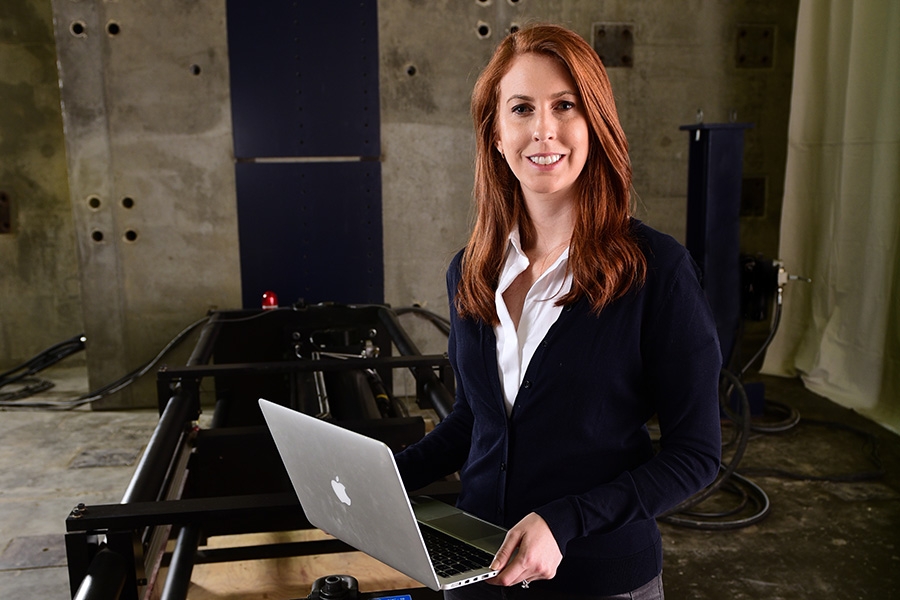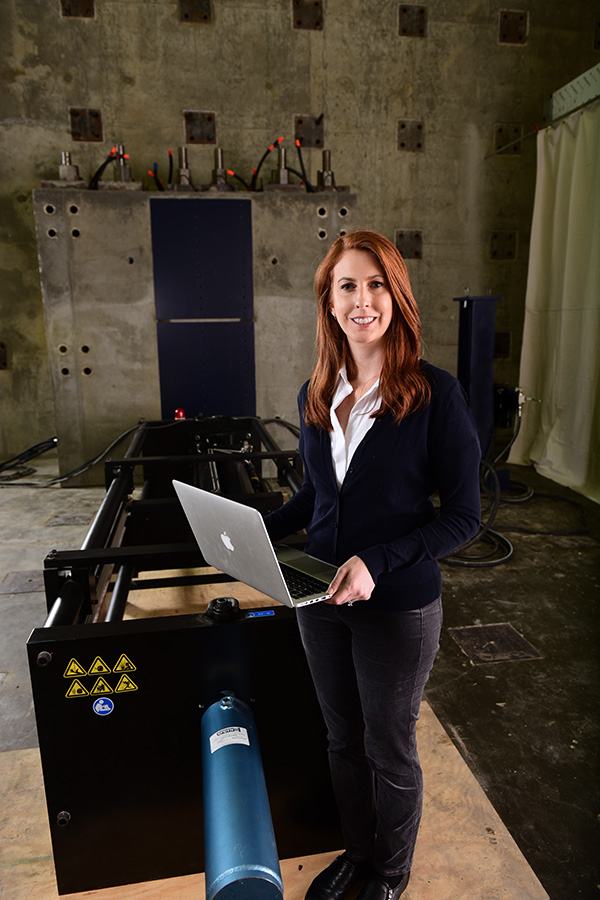
 |
By Kay Kinard, Engineers Magazine
Walking toward Lauren Stewart’s office, you immediately smell the odor of glue in the air. A quick glance around reveals model bridges in various states of completion lying about a student work area as harried undergraduates work to finish class assignments. Stewart, an assistant professor in civil and environmental engineering, teaches a beginning structures course, so this is a recurrent theme each semester. Stewart herself, however, is more at home with the smell of explosives and destruction rather than construction.
Her research is in impulsive blast mitigation — the study of high-speed, time-dependent explosive events. The Sept. 11 attacks steered Stewart toward doing her dissertation on the effects of vehicle-born explosives on steel-reinforced structures. Her current research, much of it done for the Department of Defense, focuses on blast and shock loads on structures.
• • •
What was the evolution between growing up and being here at Georgia Tech?
I was always good at science and math. From an early age, I always knew I would go into one of those fields. I liked being hands-on, and my master’s degree was in earthquake engineering. I applied for and received a Department of Defense fellowship shortly after 9/11 to look at blast effects on structures. That fellowship got me into this research area, and I haven’t looked back since.
Did 9/11 make you want to tie your structural engineering work in with the blast research?
My dad worked a lot at the Pentagon at that time; still does. We got calls that morning asking where he was. It made me cognizant about what happened to this structure, how could things be prevented. I was one of the first graduate students doing this research, but it was on my radar since the bombing at Oklahoma City. After 9/11, more funding went toward counterterrorism, so more money went into this area allowing more of us to do blast research.
How is blast research conducted?
It is a combination of field testing, where we construct and blow up an actual structure, to actually building a structure in the lab and using computer modeling and high speed visualization to observe blast and shock loads. I do a lot of applied research — what can we do now or in the future to fix the problems. I look at how we do testing to develop new designs for structures. I have a blast lab that I started building on my first day at Tech. We are able to test full-scale building structures and components by using ultra-fast hydraulics to impart the same load you would get with an explosive in less than a millisecond.
What is your lab like?
In the summer I go out in the field and spend a little time doing explosive tests on military bases. Most of the time we are in the lab using cameras and visualization techniques. Right now, one of my main research areas is looking at new experimental techniques in order to design different weapon systems for the Air Force. Blast research is a really niche field, and not very many people are doing this in academia. Most of this research is done by the military. I have 10 undergraduate researchers and eight grad students. Three of my grad students are active-duty or veterans; two are majors from the Army. My area of expertise aligns with their interests.
What is something you have learned from your research?
With blast research, we don’t design the same way as an earthquake, which is governed by Mother Nature. You look at the vulnerability of the structure and try to determine the acceptable level of risk. You can design for a certain level of explosive, but somebody can always utilize more or new technologies. We are constantly chasing an evolving threat.
What led you to Tech?
I finished grad school but I didn’t know what I wanted to do, so I worked as a post-doc and had my own startup company. Through this, I discovered I really wanted to be in the classroom. It was a really easy decision to make to come to Tech. After the interview, I felt the people were the right fit, the culture was the right fit, the students were great, and it was in a major city, which I liked.
What is it like being a woman engineer in a very male-dominant field?
I go to conferences with hundreds of people, and I am the only female in the room. I want to motivate other females to get into these fields. I bring a different viewpoint than the males do, which can be very valuable. My advice to female students is if people underestimate you because you are a woman, use it to your advantage. Being underestimated is one of the greatest competitive advantages you can have.
In my undergrad program I had no female professors. For me, I personally was still successful despite having no role models, but I do think it is important to have role models and give females similar opportunities.
In a perfect world we would not have to talk about bringing more women into engineering. We have to get to the point where we are not a rarity or exception, but the norm.
